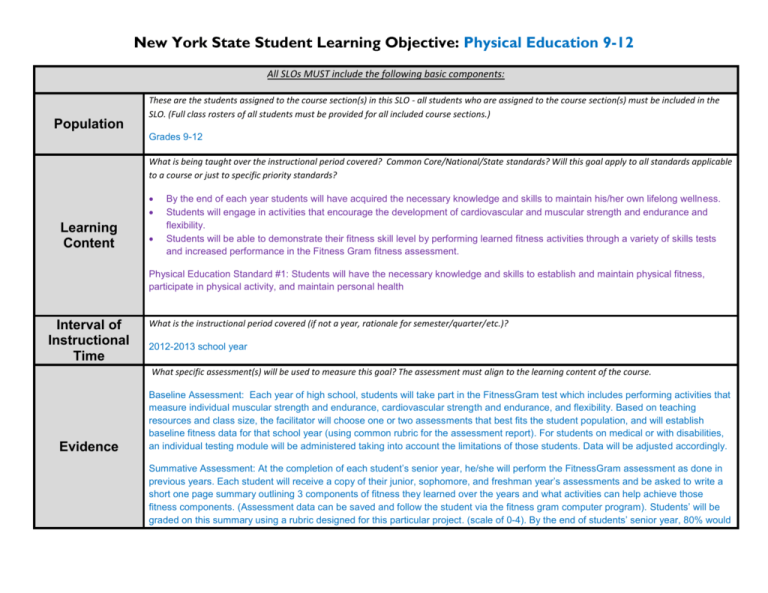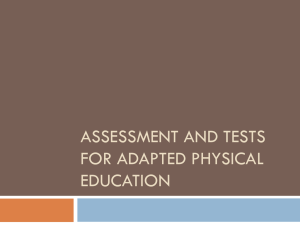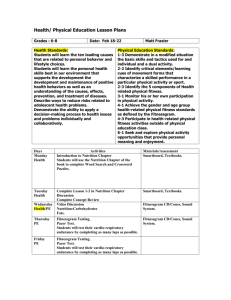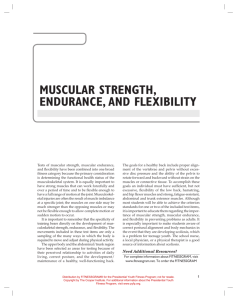New York State Student Learning Objective: Physical
advertisement

New York State Student Learning Objective: Physical Education 9-12 All SLOs MUST include the following basic components: Population These are the students assigned to the course section(s) in this SLO - all students who are assigned to the course section(s) must be included in the SLO. (Full class rosters of all students must be provided for all included course sections.) Grades 9-12 What is being taught over the instructional period covered? Common Core/National/State standards? Will this goal apply to all standards applicable to a course or just to specific priority standards? Learning Content By the end of each year students will have acquired the necessary knowledge and skills to maintain his/her own lifelong wellness. Students will engage in activities that encourage the development of cardiovascular and muscular strength and endurance and flexibility. Students will be able to demonstrate their fitness skill level by performing learned fitness activities through a variety of skills tests and increased performance in the Fitness Gram fitness assessment. Physical Education Standard #1: Students will have the necessary knowledge and skills to establish and maintain physical fitness, participate in physical activity, and maintain personal health Interval of Instructional Time What is the instructional period covered (if not a year, rationale for semester/quarter/etc.)? 2012-2013 school year What specific assessment(s) will be used to measure this goal? The assessment must align to the learning content of the course. Evidence Baseline Assessment: Each year of high school, students will take part in the FitnessGram test which includes performing activities that measure individual muscular strength and endurance, cardiovascular strength and endurance, and flexibility. Based on teaching resources and class size, the facilitator will choose one or two assessments that best fits the student population, and will establish baseline fitness data for that school year (using common rubric for the assessment report). For students on medical or with disabilities, an individual testing module will be administered taking into account the limitations of those students. Data will be adjusted accordingly. Summative Assessment: At the completion of each student’s senior year, he/she will perform the FitnessGram assessment as done in previous years. Each student will receive a copy of their junior, sophomore, and freshman year’s assessments and be asked to write a short one page summary outlining 3 components of fitness they learned over the years and what activities can help achieve those fitness components. (Assessment data can be saved and follow the student via the fitness gram computer program). Students’ will be graded on this summary using a rubric designed for this particular project. (scale of 0-4). By the end of students’ senior year, 80% would be able to score a 3 or 4 on the Fitness Gram Fitness Assessment Test and Summary project. What is the starting level of students’ knowledge of the learning content at the beginning of the instructional period? Fitness test grading rubric: 25% scored 5; 25% scored 4, 20 % scored 3, 15% 2; 15% scored 1. Pacer Push-ups Curls-ups Trunk Lift Sit and Reach 5-8 46 or less 18 or less 24 or less 8 or less 8 or less 9-11 46- 56 19-24 25-45 9 9 12-14 57-75 25-28 46-56 10 10 29-35 57-74 11 11 95 + 35 + 75 12 12 5-8 34 or less 1-2 18 or less 9-11 35-50 3-4 19-25 9 9 12-14 51-60 5-9 26-40 10 10 15-17 61-74 10-14 41-74 11 11 18-20 75+ 15+ 75 12 12 Boys (points per test): 15-17 Baseline 18-20 76-90 Girls(points per test): 8 or less 8 or less *Students that didn’t not perform any of the fitness gram, or only performed part of it will be graded on a scale of 0-5 points per testing activity. What is the expected outcome (target) of students’ level of knowledge of the learning content at the end of the instructional period? Target(s) 80% of students will score a 3 or a 4 on their one page summary project. How will evaluators determine what range of student performance “meets” the goal (effective) versus “well-below” (ineffective), “below” (developing), and “well-above” (highly effective)? See ranges below, based on baseline data and district history. HEDI Scoring Highly effective Effective 20 19 18 17 16 -100% 9798% 95 -96 92-94% 8891% Developing 15 14 13 12 11 10 9 8 7 8587% 8284% 7981% 7678% 7375% 7172% 6870% 64-67%6063% ineffective 6 5 4 3 2 1 5759% 53 -56 4952% 4548 4044% 3039% <30 Describe the reasoning behind the choices regarding learning content, evidence, and target and how they will be used together to prepare students for future growth and development in subsequent grades/courses, as well as college and career readiness. The Fitnessgram is an educational tool that helps students learn—as part of a high quality, standards-based physical education curriculum—how it feels to become more physically fit, and how to value a physically active lifestyle. Rationale Fitnessgram is a team effort. It requires participation of teachers, administrators, and technology staff. The benefits are immense—Fitnessgram can help a physical education program define its goals and bring everyone on board with those common goals. www.fitnessgram.net








